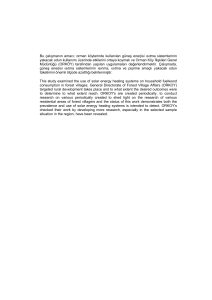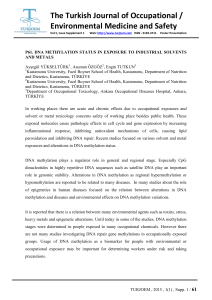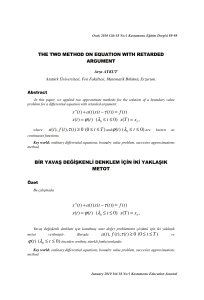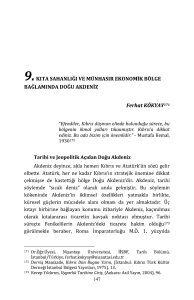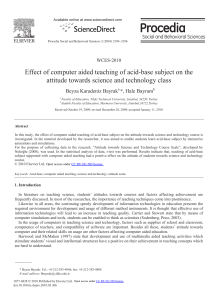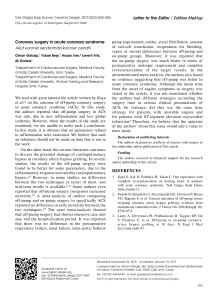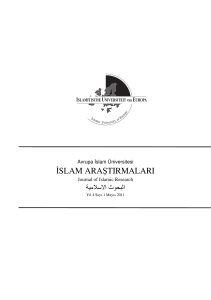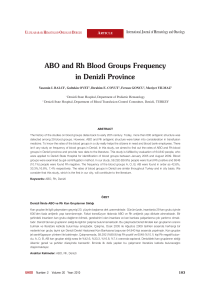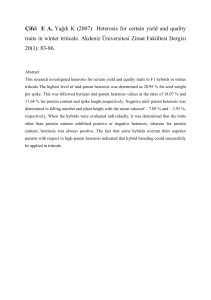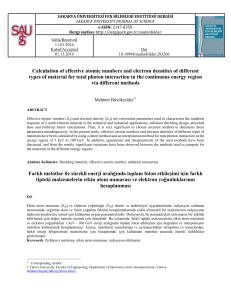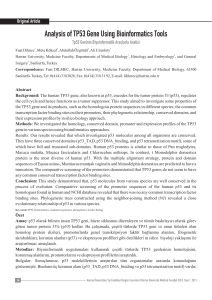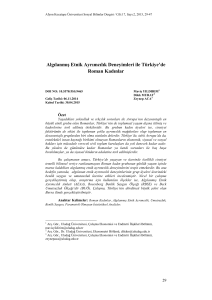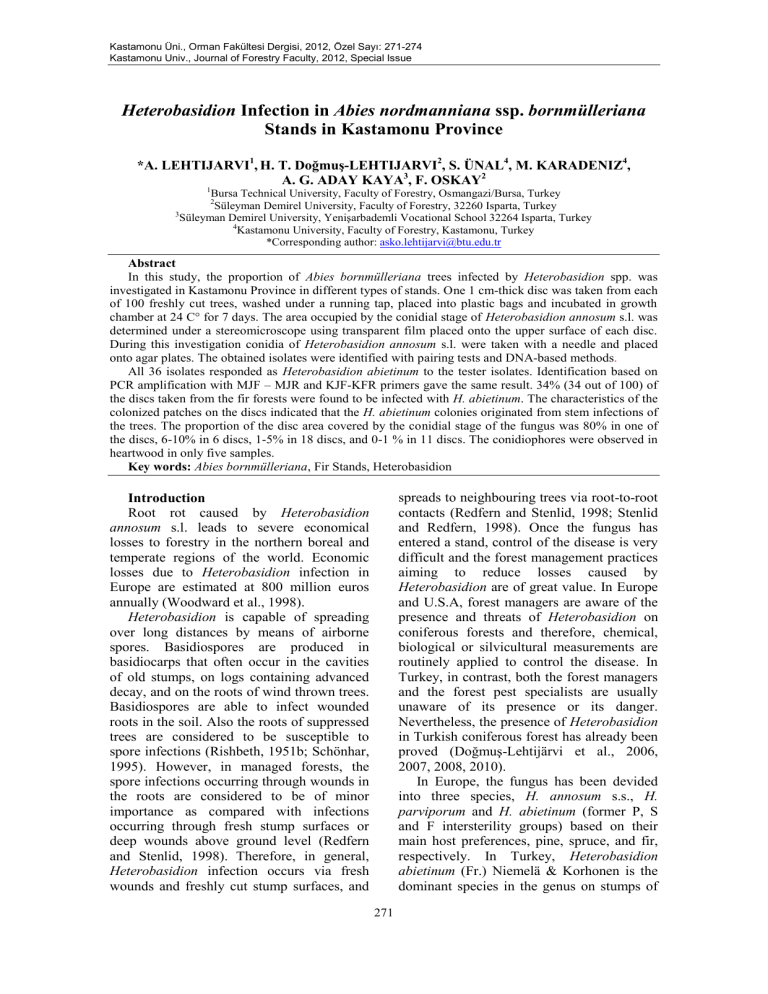
Kastamonu Üni., Orman Fakültesi Dergisi, 2012, Özel Sayı: 271-274
Kastamonu Univ., Journal of Forestry Faculty, 2012, Special Issue
Heterobasidion Infection in Abies nordmanniana ssp. bornmülleriana
Stands in Kastamonu Province
*A. LEHTIJARVI1, H. T. Doğmuş-LEHTIJARVI2, S. ÜNAL4, M. KARADENIZ4,
A. G. ADAY KAYA3, F. OSKAY2
1
Bursa Technical University, Faculty of Forestry, Osmangazi/Bursa, Turkey
Süleyman Demirel University, Faculty of Forestry, 32260 Isparta, Turkey
3
Süleyman Demirel University, Yenişarbademli Vocational School 32264 Isparta, Turkey
4
Kastamonu University, Faculty of Forestry, Kastamonu, Turkey
*Corresponding author: [email protected]
2
Abstract
In this study, the proportion of Abies bornmülleriana trees infected by Heterobasidion spp. was
investigated in Kastamonu Province in different types of stands. One 1 cm-thick disc was taken from each
of 100 freshly cut trees, washed under a running tap, placed into plastic bags and incubated in growth
chamber at 24 C° for 7 days. The area occupied by the conidial stage of Heterobasidion annosum s.l. was
determined under a stereomicroscope using transparent film placed onto the upper surface of each disc.
During this investigation conidia of Heterobasidion annosum s.l. were taken with a needle and placed
onto agar plates. The obtained isolates were identified with pairing tests and DNA-based methods.
All 36 isolates responded as Heterobasidion abietinum to the tester isolates. Identification based on
PCR amplification with MJF – MJR and KJF-KFR primers gave the same result. 34% (34 out of 100) of
the discs taken from the fir forests were found to be infected with H. abietinum. The characteristics of the
colonized patches on the discs indicated that the H. abietinum colonies originated from stem infections of
the trees. The proportion of the disc area covered by the conidial stage of the fungus was 80% in one of
the discs, 6-10% in 6 discs, 1-5% in 18 discs, and 0-1 % in 11 discs. The conidiophores were observed in
heartwood in only five samples.
Key words: Abies bornmülleriana, Fir Stands, Heterobasidion
spreads to neighbouring trees via root-to-root
contacts (Redfern and Stenlid, 1998; Stenlid
and Redfern, 1998). Once the fungus has
entered a stand, control of the disease is very
difficult and the forest management practices
aiming to reduce losses caused by
Heterobasidion are of great value. In Europe
and U.S.A, forest managers are aware of the
presence and threats of Heterobasidion on
coniferous forests and therefore, chemical,
biological or silvicultural measurements are
routinely applied to control the disease. In
Turkey, in contrast, both the forest managers
and the forest pest specialists are usually
unaware of its presence or its danger.
Nevertheless, the presence of Heterobasidion
in Turkish coniferous forest has already been
proved (Doğmuş-Lehtijärvi et al., 2006,
2007, 2008, 2010).
In Europe, the fungus has been devided
into three species, H. annosum s.s., H.
parviporum and H. abietinum (former P, S
and F intersterility groups) based on their
main host preferences, pine, spruce, and fir,
respectively. In Turkey, Heterobasidion
abietinum (Fr.) Niemelä & Korhonen is the
dominant species in the genus on stumps of
Introduction
Root rot caused by Heterobasidion
annosum s.l. leads to severe economical
losses to forestry in the northern boreal and
temperate regions of the world. Economic
losses due to Heterobasidion infection in
Europe are estimated at 800 million euros
annually (Woodward et al., 1998).
Heterobasidion is capable of spreading
over long distances by means of airborne
spores. Basidiospores are produced in
basidiocarps that often occur in the cavities
of old stumps, on logs containing advanced
decay, and on the roots of wind thrown trees.
Basidiospores are able to infect wounded
roots in the soil. Also the roots of suppressed
trees are considered to be susceptible to
spore infections (Rishbeth, 1951b; Schönhar,
1995). However, in managed forests, the
spore infections occurring through wounds in
the roots are considered to be of minor
importance as compared with infections
occurring through fresh stump surfaces or
deep wounds above ground level (Redfern
and Stenlid, 1998). Therefore, in general,
Heterobasidion infection occurs via fresh
wounds and freshly cut stump surfaces, and
271
Kastamonu Üni., Orman Fakültesi Dergisi, 2012, Özel Sayı: 271-274
Kastamonu Univ., Journal of Forestry Faculty, 2012, Special Issue
native Abies taxa: Abies cilicica (Ant. &
Kotsch.) Carr., A. nordmanniana ssp.
bornmülleriana (Mattf.) Coode & Cullen, A.
nordmanniana ssp. equi-trojani (Aschers &
Sint. ex Boiss.) Coode & Cullen and A.
nordmanniana
(Steven)
Spach
ssp.
nordmanniana (Doğmuş-Lehtijärvi et al.
2006, 2007). The disease incidence caused
by Heterobasidion has received little
attention on fir in Turkey until now.
Recently, Doğmuş-Lehtijärvi et al. (2008)
demonstrated that the disease incidence on
freshly-cut stumps of approximately 90 yearold A. cilicica and 75- and 120 year-old A.
nordmanniana ssp. bornmülleriana was 11.5,
18.8 and 28.2%, respectively.
Sampling area
Küre
Ilgaz (Kırkpınar yaylası)
Coordinates
36 560 367 D
46 27 772 K
36 553 286 D
45 399 30 K
Lehtijarvi et al.
The aim of this study was to investigate
the incidence of butt rot caused by H.
annosum s.l. in A. nordmanniana ssp.
bornmülleriana stands in Western Black Sea
Region of Turkey.
Material and Methods
Study sites and ecological characterisation
This study was carried out in two stands
of A. nordmanniana ssp. bornmülleriana in
Western Black Sea Region of Turkey in
Kastamonu province (Fig. 1). The size of the
stands varied between 0.6-10 hectares. The
age of the stands was 25-80 years (Table 1).
Altitude (m)
1018
Status
Managed forest
Stand properties
Pure stand
1795
Managed forest
Mixed with Pinus sylvestris
Figure 1. Location of sampling areas in Kastamonu province
determined as described in Korhonen (2003).
A transparent film with a sq.cm grid was
fixed onto the upper surface of each disc and
the area occupied by the conidial stage of the
fungus determined under a stereomicroscope.
During this investigation, conidia of H.
annosum s.l. were taken with a needle and
placed onto malt-extract agar (Merck) plates.
The isolates were paired with known tester
strains. The pairings were made in Petri
plates containing malt extract agar medium.
The inoculates were approximately 5 mm
apart from each other and they were
incubated at room temperature for 3 to 5
weeks. After this period, the change of the
Field survey and sample collection
In each of the two stands, 50 A.
nordmanniana ssp. bornmülleriana trees
were randomly selected according to root rot
symptoms and cut with a chainsaw. Discs
were placed into nylon bags and brought to
the laboratory. Height and d.b.h. of sampled
trees were recorded.
Fungal isolation and Assessment of
Heterobasidion species based on DNA
techniques
Discs (without washing or removing the
bark) were incubated in the dark at room
temperature (approx. 23 ºC) for 7 days. The
area colonized by H. annosum s.l. was
272
Kastamonu Üni., Orman Fakültesi Dergisi, 2012, Özel Sayı: 271-274
Kastamonu Univ., Journal of Forestry Faculty, 2012, Special Issue
mycelial appearance and occurrence of clamp
connection were observed.
Prior to DNA extraction, fungal isolates
were grown on agar media covered with
cellophane membrane at 25°C for two weeks.
After incubation the growing mycelia was
collected and ground in liquid nitrogen in a
mortar. Fungal DNA was extracted using
DNeasy Plant Mini Kit (Qiagen). DNA of
each isolates was amplified with MJF
(GGTCCTGTCTGGCTTTGC) and MJR
(CTGAAGCACACCTTGCCA) and KJF
(CCATTAACGGAACCGACGTG)
and
KFR (GTGCGGCTCATTCTACGCTATC)
primers specific to H. annosum s.str and H.
parviporum respectively. The amplifications
were carried out using a ‘hot start’ protocol
where DNA samples and primers (each in a
Lehtijarvi et al.
concentration of 0.5 uM) were denaturated at
+95 °C for 10 minutes, after which a dNTPmix (each deoxynucleotide in a concentration
of 0.2 mM) and 20 U/ml of DNA-polymerase
(Promega) were added. Then 40 cycles of
amplification (30 s denaturation at 95 °C, 35
s annealing at 67 °C, 1 min extension at 72
°C) and a final extension of 7 minutes were
carried out.
Results and Discussion
A total of 100 trees were examined, of
which 33 contained advanced decay and
were found by inspection to be caused by H.
annosum. All fungal isolates were
determined to be H. abietinum, based on
morphological and DNA-based techniques.
Table1. Laboratory and field results
A. bornmülleriana
Küre
Mean
Ilgaz
Mean
Disease incidence (%)
Diameter
Min-max
27-50
13
11
Min-Max
25-70
Annosum root and butt rot incidence
varied between sampled stands, 28-34% on
average (Table 1).
There was a positive correlation between
stand age and root rot frequency (r = 0.317, p
< 0.001). Larger stumps were more likely to
contain decay.
The present study indicates that about
one-fifth of A. bornmülleriana trees in
Kastamonu province in Black Sea region
forests are infected by Heterobasidion
abietinum and that infection frequency
among individual stands varies greatly. The
results are comparable with 11.5, 18.8 and
28.2% rot frequency (Doğmuş-Lehtijärvi et
al., 2007, 2008, 2010) detected during
previous inventories in Turkish fir forests.
At high altitudes the incidence of disease
is lower than at sea level, probably due to
climatic factors and a shorter growing season
(Korhonen & Stenlid, 1998). The extension
of decay is also affected by genotype to the
same extent as other investigated traits, e.g.
height growth (Swedjemark, Stenlid &
Karlsson, 1997, 2001; Swedjemark &
Karlsson, 2002, 2004).
20
22
Total
Mean
Min-Max
26-60
43
H. abietinum occurs generally more
frequently in managed pure fir forests than in
mixed stands. Additionally, butt rot
frequency in a stand is influenced by
different factors such as site history, site
management, previous tree rotation, and stem
damage by game (Isomäki and Kallio, 1974;
Swedjemark and Stenlid, 1993; Piri, 2003).
In forests lacking previous management, the
fungus seldom causes significant damage to
the trees (Korhonen et al., 1998; Redfern and
Stenlid, 1998). The high infection incidence
of H. abietinum in pure stand in Küre was
most likely due to the spread via root contact
and recent cuttings in the forest.
Felling in warmer seasons during the
growth period creates a higher risk of
infection of the trees by pathogens via both
fresh stumps, which are known as the main
Heterobasidion spp. infection source, and
mechanical wounds (Rönnberg, 2000;
Vasiliauskas, 2002).
This study showed that H. abietinum is
the main cause of butt rot in Kastamonu
province in A. bornmülleriana stands, which
indicates that such forest sites are
273
Kastamonu Üni., Orman Fakültesi Dergisi, 2012, Özel Sayı: 271-274
Kastamonu Univ., Journal of Forestry Faculty, 2012, Special Issue
Lehtijarvi et al.
Ed. by Woodward, S.; Stenlid, J.; Hu¨ ttermann,
A.; Karjalainen, R. Oxon, New York: CAB
International, pp. 105–124.
Stenlıd, J., 1994b. Regional differentiation in
Heterobasidion annosum. In: Johansson, M. and
Stenlid, J. (Eds), Proceeding of the Eight IUFRO
Conference on Root and Butt Rots.
Sweden/Finland
August
1993.
Swedish
University of Agricultural Sciences, Uppsala,
Sweden, pp. 243-248.
Stenlid, J. and Wästerlund, I., 1986.
Estimating the frequency of stem rot in Picea
abies using an increment borer. Scandinavian
Journal of Forest Research, 1, 303-308.
Swedjemark, G. and Stenlid, J., 1993.
Population dynamics of the root rot fungus
Heterobasidion annosum following thinning of
Picea abies. Oikos 66: 247- 254.
Vasiliauskas, R., Juska, E., Vasiliauskas, A.,
Stenlid, J., 2002. Community of Aphyllophorales
and root rot in stumps of Picea abies on clearfelled forest sites in Lithuania. Scand. J. Forest
Res. 17, 398–407.
permanently infested and that the disease will
persist over future forest generations.
Acknowledgments
This study was supported by the SDÜBAP “1025-M-10” project by Süleyman
Demirel University. We are also thankful to
forest organizations for their help during the
field surveys.
References
Bendz- Hellgren, M., Lipponen, K., Solheim,
H., Thomsen, I.M., 1998. The Nordic countries.
In: Woodward, S., Stenlid, J., Karjalainen, R.,
Hüttermann, A. (Eds), Heterobasidion annosum:
Biology, Ecology, Impact and Control, CAB
Internatinal, Wallingford, UK, pp. 333- 345.
Doğmuş-Lehtıjärvı, H.T., Lehtijärvi, A. and
Korhonen, K., 2006. Heterobasidion abietinum
on Abies species in western Turkey. Forest
Pathology, 36 (4), 280-286.
Doğmuş- Lehtıjärvı, H.T., Lehtijärvi, A.,
Hatat- Karaca, G., Aday, A.G., 2007b.
Heterobasidion annosum s. l.'un Uludağ
göknarında oluşturduğu alt gövde çürüklüğünün
arazi ve laboratuar metotları ile tespiti. S.D.Ü.
Orman Fakültesi Dergisi. Seri A, Sayı 1: 58–67.
Doğmuş Lehtijärvi, H.T., Lehtijärvi, A.,
Aday, A.G., Oskay, F. Annosum kök
Çürüklüğüne Karşı Uygulanan Biyolojik Kontrol
Ajanı; Phlebiopsis gigantea. 3. Ulusal Karadeniz
Ormancılık Kongresi, 20-22 Mayıs 2010, Artvin.
Cilt IV: 1403–1410
Korhonen, K., 1978. Intersterility groups of
Heterobasidion annosum. Communicationes of
Instituti Forestalis Fenniae 94 (6), 25-25.
Korhonen, K., Capretti, P., Karjalainen, R.
and Stenlid, J., 1998. Distribution of
Heterobasidion annosum intersterility groups in
Europe. In: Heterobasidion annosum. Biology,
Ecology, Impacr and Control. Ed by Woodward,
S., Stenlid, J., Huttermann, A., Karjalainen, R.
Oxon, New York: CAB International, 93-104.
Pırı, T., Korhonen, K. and Sairanen, A., 1990.
Occurence of Heterobasidion annosum in pure
and mixed spruce stands in Southern Finland.
Scandinavian Journal of Forest Research 5, 113125.
Redfern, D. B. and Stenlid, J., 1998. Spore
dispersal and infection. In: Heterobasidion
annosum. Biology, Ecology, Impact and Control.
274

